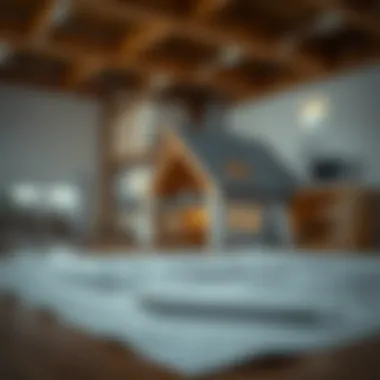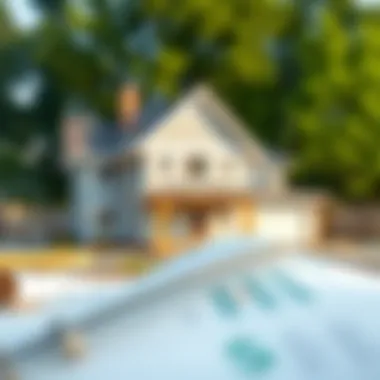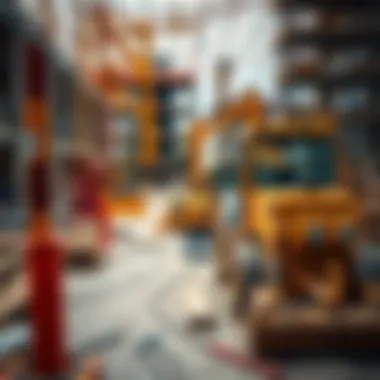Essential Steps to Build Your Own House Successfully


Intro
Building your own home can be a major life event. It's not just about erecting walls and slapping on some paint; it’s a winding road filled with twists and turns. At the heart of this journey lies a blend of vision, investment, and practicality. To make sense of such a complex process, one must dive into the nitty-gritty of planning, budgeting, and adhering to regulatory requirements.
Understanding the path ahead is crucial. Many people dream of having their own space, a place that reflects their values and lifestyle. Yet, the prospect of managing a construction project can seem daunting. Thankfully, breaking it down into manageable steps can turn what appears to be an overwhelming experience into something much more feasible.
This guide aims to explore the essential aspects of house building, offering insights that empower you as a reader. From initial blueprints dancing in your mind to the satisfying sense of accomplishment when the last nail is driven, every corner and detail matters. The following sections will cover budgeting strategies, design choices tailored to your lifestyle, and the myriad of regulations that you must navigate.
In essence, this journey is about more than brick and mortar. It’s a personal investment and an endeavor that involves careful consideration and strategic planning. Get ready to roll up your sleeves, gather your resources, and transform your dream into reality.
Understanding Your Vision
Embarking on the journey of constructing a home is not merely about bricks and mortar; it's about materializing a vision that represents who you are and how you wish to live. The importance of understanding your vision can't be overstated. It serves as a compass throughout the building process, guiding every choice from design to location. Without a clear vision, you may find yourself floundering amidst a sea of decisions, swayed by trends or high-pressure sales tactics.
This vision encompasses more than just aesthetics. It represents functionality, lifestyle, and personal values. Are you looking for a contemporary farmhouse or a minimalist-style bungalow? Such choices are influenced by your personal tastes, family needs, and even lifestyle aspirations. Moreover, defining your vision equips you with a framework for setting goals and making informed decisions along the journey of home building. Overall, it forms the bedrock upon which your entire project stands.
Defining Your Requirements
To effectively define your requirements, it's prudent to engage in a deep reflection about your lifestyle needs and future aspirations. Picture the moments that matter most to you. Do you thrive on hosting family gatherings, or are quiet evenings more your style? Pinpointing essential requirements might involve the following considerations:
- Number of Bedrooms and Bathrooms: Will you need space for future expansion?
- Home Office Needs: With remote work becoming the norm, a dedicated workspace is often essential.
- Accessibility Concerns: Plan for aging gracefully in your home, necessitating features like wider doorways or single-story layouts.
By jotting down these requirements, you can better convey your ideas to architects and builders. A precise list assists in keeping your vision aligned as you navigate through design and construction phases.
Choosing a Suitable Location
Location is more than just a bullet point on your wishlist; it plays a pivotal role in defining your lifestyle. An ideal location encompasses a range of factors including:
- Proximity to Work and Schools: Accessibility to employment and education can directly affect your daily routine.
- Community Vibe and Amenities: Look for areas that resonate with your social needs. A neighborhood with parks, cafes, and schools often enhances quality of life tremendously.
- Future Growth Opportunities: Consider areas versatile for future development. Investing in a growing community could yield long-term financial benefits.
Before settling, spend time in your potential neighborhood. Visit local shops, chat with residents, and gauge the overall atmosphere. Understanding how location ties into your larger vision will help make a decision that's both sound and fulfilling.
"Home is where your story begins."
Choosing wisely will set the foundation for everything that follows in the home-building process. It’s a blend of immediate satisfaction and long-term strategy, ensuring that your vision corresponds well with your surroundings.
Developing a Comprehensive Budget
Building a house isn’t just about bricks and mortar; it’s a financial balancing act. A comprehensive budget serves as a foundation, ensuring that your dreams don’t crumble under the weight of unforeseen costs. The significance of creating a detailed budget cannot be overstated. Not only does it provide a monetary roadmap, but it also lays the groundwork for informed decisions throughout the building process. Whether you’re an experienced investor or a first-time builder, understanding how to structure your financial resources effectively is crucial for staying on course.
Estimating Costs
Estimating costs is the heartbeat of any budget. It requires thorough research and honesty about what you can afford. Begin by listing out the major expenses involved, such as land acquisition, building materials, labor, and any additional fees for permits and inspections. Don’t forget about soft costs, which are as significant as hard costs—things like design fees, landscaping, and utilities need to be factored in too.
A well-prepared estimate can safeguard you against nasty surprises down the line. For instance, remember that prices for materials can fluctuate, often based on market demand. Keeping a buffer of around 10% to 15% for unexpected expenses is a wise strategy. A budget that accommodates wiggle room enables you to maintain composure when surprises arise.
A comprehensive budget is less about squeezing every penny and more about creating flexibility within your financial landscape.
Understanding Financing Options
Financing options form an integral part of your budget considerations. Without robust knowledge of how to go about funding your dream home, your financial plan may face pitfalls. Let’s break down some popular financing avenues that might suit your needs:
Conventional Loans
Conventional loans are akin to a trusted pair of shoes; they can often get you where you need to go without bunching up or pinching. This kind of loan is not backed by any government entity, which makes it ideal for buyers with good credit who can afford a decent down payment. One key characteristic is the fixed interest rate that offers stability over the repayment period.
A standout aspect of conventional loans is their flexibility, allowing you to choose terms that best suit your financial situation—be it 15, 30 years or more. They do come with stricter qualification requirements, which can be a double-edged sword. On one side, securing a typical conventional loan can be easier for those with higher credit scores; on the other side, it could be inaccessible for those still working to improve theirs.
Construction Loans
Construction loans are specifically designed for the short-term funding of your building project. They hold considerable appeal for people who want to finance the process of constructing a new home rather than buying one outright. One of their defining traits is the short repayment period, which often lasts just a year or so.
A construction loan rolls out like a phased financing plan—funds are disbursed at various stages of the build, which helps in controlling costs as you progress. However, with this perk comes the added complexity of meeting different criteria at each phase of the project, making them a bit tricky to navigate, especially for first-timers.
Government Programs
Government programs can also come in handy for those looking to take the financial weight off their shoulders. Various state and federal initiatives are available, aimed at helping specific groups like first-time homebuyers or low-income families. Many of these programs offer favorable terms, low-interest rates, and down payment assistance.
Among the key characteristics of government programs is accessibility—they can help folks who might otherwise struggle to enter the housing market. Yet, they can also impose limitations, such as geographic restrictions or specific eligibility criteria based on income levels, which may not suit everyone’s situation.


Engaging with Professionals
Building a house is a monumental endeavor, one that requires a blend of expertise, vision, and practical know-how. Engaging with professionals is not just beneficial; it’s essential in ensuring that your project flows smoothly and adheres to regulations and quality standards. An experienced architect can transform your sketches into practical designs, while knowledgeable builders can interpret those designs into reality.
Having the right team in your corner saves time, mitigates risks, and often protects your investment. It’s like assembling a crew for a ship; you wouldn’t set sail without a capable captain and a trusted navigator. The most trivial oversight can lead to hefty costs and delays, which can spiral out of control before you even have the chance to blink. Therefore, understanding whom to engage—and how—becomes a priority in the maze of home building.
Selecting Architects and Designers
Architects and designers play a pivotal role in laying the groundwork for your future home. They help capture your vision, translating it into blueprints that reflect your tastes and fit functional needs.
Why Choose Professional Designers?
- Skillful Design Creation: Architects bring creativity combined with knowledge of building codes and regulations. They can introduce elements that maximize space and efficiency, often incorporating innovative solutions you hadn't considered.
- Bespoke Planning: These professionals can customize every detail from layout to façade—essential for creating a home that truly resonates with your style.
- Project Coordination: They act as the point of contact during the building phase, coordinating with contractors and helping you avoid common construction pitfalls.
When choosing an architect, look for someone whose aesthetic aligns with yours. Recent projects, client reviews, and even personal chemistry matter. The last thing you want is a creative gap between your vision and their interpretation.
Choosing Builders and Contractors
While the architect provides the plans, the builders and contractors turn those plans into brick and mortar. Choosing the right builder can make or break your construction journey.
Important Considerations
- Reputation and Experience: Look for builders with solid reputations. Word of mouth, online reviews, and star ratings on platforms can be very telling.
- Specialization: Some builders may specialize in specific home styles or materials—be sure to find one that fits your project.
- Transparent Communication: Good builders keep you in the loop; they don’t leave you guessing about timelines or costs.
Building is not merely about timeframes and budgets; there’s a relationship at play. Trust is paramount. You need a team that understands your end goal and leads with transparency.
Involving Engineers and Surveyors
Engineers and surveyors are often the unsung heroes of home building. Surveyors set the foundational stage by assessing your plot, understanding the land's geography, and ensuring that the land is fit for construction. Engineers, on the other hand, take the architectural designs and add the crucial elements of structural integrity.
Why They Matter
- Site Evaluation: Engineers conduct thorough land assessments, clarifying potential challenges that might skew project timelines or budgets. They uncover soil conditions, drainage issues, and other factors critical for the project's success.
- Design Compliance: They ensure your building adheres to safety standards and regulations. This keeps your investment safeguarded against future hazards or legal complications.
- Optimized Structural Planning: Engineers provide insights into the materials and methods best suited for your home. This informed approach can lead to long-term savings on maintenance and energy efficiency.
Overall, surrounding yourself with proficient professionals can usher your building project into a realm of quality that stands the test of time. The right choices mean fewer headaches down the line and ultimately lead to a stronger and more captivating home—one that embodies the aspirations you set in motion from the beginning.
"A house is made of walls and beams; a home is built with love and dreams."
For further insights on this topic, consider resources from Wikipedia and Architectural Digest. Investing time to research and engage with qualified professionals is the cornerstone of creating a successful building experience.
Navigating Permits and Regulations
Building a home isn’t just about nailing boards together and picking out paint colors. One of the most crucial steps in the process is addressing permits and regulations. Without navigating these murky waters properly, your dream abode could be built on shaky legal ground, quite literally and figuratively. Getting acquainted with the rules can save you from hefty fines down the road, as well as ensure that your home is safe, secure, and compliant with local standards.
Understanding Zoning Laws
Zoning laws define how land in different areas can be used. These regulations dictate aspects such as the type of buildings allowed, setbacks, height restrictions, and sometimes even the colors of the structures in specific neighborhoods. Ignoring these rules can lead to severe penalties, including the potential demolition of your newly constructed home. You might think it's just a piece of paper, but this legal framework establishes the foundation for successful home building.
- Know Before You Grow: Before you even buy the land, check with your local zoning office or municipal website. Knowing if the lot is zoned for residential use can save you heartache later.
- Updates and Exceptions: Zoning laws aren’t set in stone. Sometimes there are exceptions or variances you can apply for, which allows for flexibility depending on your plans.
- Local Insights: Engage with local community boards or groups. They often have insights about zoning that are not written in regulations. It’s a smart way to learn about neighborhood dynamics that zoning laws don’t cover.
By comprehending zoning laws, you’re setting yourself up to successfully navigate the complexities ahead. It’s like having a roadmap before diving into a new city—you wouldn’t want to get lost, right?
Obtaining Necessary Permits
Once you’ve varied the zoning hurdles, it’s time to focus on permits. Obtaining the right permits is essential to legalize your construction activities and ensure that everything meets safety codes. Here’s what you need to keep in mind:
- Building Permits: This is usually the first permit you’ll need. It confirms that your construction plans comply with local building codes and safety regulations. Understand that different municipalities often require specific plans and even inspections during different phases of construction.
- Electrical and Plumbing Permits: If you're planning on installing new electrical systems or plumbing, you’ll most likely need specialized permits for those. Just don’t think of them as red tape; they assure that everything is up to code, which protects you and future occupants.
- Environmental Permits: Depending on where you build, especially if it’s near a wetland or historical site, you might need extra permits. These help protect natural resources and cultural heritage.
- Follow-up Inspections: After you get your permits, expect inspections at various stages. These are not only to ensure compliance but also to give you the peace of mind that your structure is built on solid ground—literally and metaphorically.
It’s advisable to keep a detailed record of all permits and communications with municipal offices. It can save you a world of trouble later down the path.
In summary, while navigating permits and regulations may seem daunting, it’s absolutely necessary for a seamless construction experience. Putting in the effort now to understand the landscape can pay off significantly when your house becomes a home.
Design and Layout Considerations
Design and layout considerations are paramount when embarking on the adventure of constructing your own house. The right design speaks volumes, not just about aesthetics, but also how daily life swirls around in each space of the home. This phase is where the blueprint of dreams starts to take shape, merging personal style with functional needs. It's like piecing together a puzzle where each piece must fit seamlessly, enabling a harmony that contributes to a comfortable living environment.
Functional Floor Plans
When it comes to functional floor plans, careful thought is needed. The layout of a home doesn't just dictate where rooms sit; it controls the flow of life within those walls. A well-thought-out floor plan enhances mobility, providing an intuitive path from one area to another. Ideally, the plan should consider the habits of inhabitants. For example, a family with young children might prefer a design that clusters sleeping quarters close to shared living spaces, while a couple might lean toward more separate lounging areas for relaxation that gives each other personal space.


Consider the following points when fleshing out your floor plan:
- Space Utilization: Ensure each square foot of the layout serves a purpose. Unused or underused spaces can drain resources and energy.
- Zoning: Create zones to separate public and private areas. The kitchen, dining, and living room comprise the social hub of a house, while bedrooms offer sanctuary.
- Natural Light: Efficient floor plans account for windows and lighting placement. Taking advantage of natural light can transform spaces, giving them life and warmth.
For someone pouring their heart and funds into a new build, having a practical floor plan isn't just about convenience; it’s central to an enriching lifestyle.
Incorporating Sustainable Practices
Sustainable practices in design are not just trends; they’re a vital part of modern home building embracing holistic approaches that are beneficial for the planet and the wallet. When embarking on the layout phase, integrating sustainability should resonate in decisions from materials to energy efficiency.
Some sustainable considerations include:
- Energy-Efficient Design: Orientation of the home can be optimized for solar gain. A structure facing south captures maximum sunlight in colder months, potentially reducing heating costs.
- Materials: Choosing sustainable materials is key. Reclaimed wood and recycled materials not only have minimal environmental impact but also provide unique character to spaces.
- Water Conservation: Implementing greywater systems or rainwater collection for irrigation reduces reliance on municipal water sources, maintaining environmental responsibility while preserving resources.
Incorporating these practices is a win-win scenario. You’re not just crafting a beautiful dwelling, but also establishing a home that respects its environment, fostering a legacy of stewardship.
Designing your home with sustainability in mind is like planting a seed for future generations, allowing them to flourish in a healthy environment.
Balancing functionality and sustainability is an art, but it lays down a solid foundation for creating a home that truly reflects your ethos and values. Thus, thoughtful consideration of design and layout stands critical in navigating the broader journey of home building, ensuring the ultimate goal of not just building a house, but establishing a lasting home.
Managing the Construction Process
Managing the construction process is like being the conductor of an orchestra. Each section needs to play its part, and timing is crucial. A well-managed construction phase ensures not only that your dream home becomes a reality but does so on time and within budget. The process involves coordination between various parties and keeping a close eye on everything from labor to materials. It’s essential not just for aesthetic completeness but also for safeguarding your investment against any potential pitfalls.
By fine-tuning every cog in the construction machine, you can mitigate risks and enhance the likelihood of a smooth project. This stage is where all prior planning comes to fruition, so understanding the specific elements involved can save both time and money in the long run.
Scheduling and Timeline Management
Time waits for no one, and in the realm of home construction, time is money. A detailed schedule acts as a roadmap, outlining every crucial phase of construction, allowing for clear visibility of the project's progress. When constructing a house, you must break down timelines into manageable milestones.
- Site Preparation and Foundation
This is where it all begins. Set a timeline to clear and prepare the site, followed by laying down the foundation. Allow enough time for curing if you're using concrete for stability. - Framing and Roofing
After the foundation, the next step is framing. Ensure your schedule allows for delays due to weather—better to err on the side of caution. - Mechanical, Electrical, and Plumbing Installation
Architects and contractors might say that it's the heart of the home; scheduling these ensure everything runs smoothly, right from the start. - Finishing Touches
This includes interior and exterior work. Allocate time wisely here as well; rushing can lead to hasty mistakes that are hard to fix.
Setting a timeline isn't just about checking boxes. You also need to communicate openly with contractors and suppliers to manage expectations. Regular check-ins allow you to address potential delays early on. Maintaining flexibility within your schedule is equally crucial. In construction, hiccups are practically guaranteed, so staying adaptable helps keep frustrations at bay.
Quality Control Measures
Quality control during the construction phase is paramount. It's the difference between a house and a home. Having consistent quality checks prevents issues from snowballing down the line. Here’s what quality control should include:
- Regular Inspections: Schedule routine inspections at various stages of the project, from framing, finishing to final checks. This ensures everything conforms to the building codes and the agreed-upon design.
- Documentation: Consider keeping a quality control log. This should detail inspections, any findings, and corrective actions taken. This not only helps you track the quality of workmanship but also creates a timeline of accountability.
- Engage Third-Party Inspectors: Bringing in unbiased inspectors adds an extra layer of oversight. They can provide expertise that you or your contractors may overlook.
"Quality is not an act, it is a habit."
This ancient saying rings true in construction. Maintaining high-quality standards ensures that your dream home not only meets your expectations but stands the test of time.
By focusing on scheduling and implementing robust quality control measures, you craft a construction experience that is organized, efficient, and productive, leading to a home that will serve you well for many years. Ensure all parties remain informed and committed to quality, and you’ll likely look back on this phase as one marked by success instead of stress.
Interior and Exterior Finishing
In the world of home construction, the terms interior and exterior finishing are not merely buzzwords. These are the final touches that breathe life into the structure, transforming bare walls and rough exteriors into a haven that echoes your personal style. This stage is vital, not just for aesthetics, but also for enhancing property value and functionality. A well-finished home can feel welcoming, while a poorly executed finish can leave glaring gaps that detract from the overall appeal. It's kind of like putting icing on a cake—your home deserves the best to truly shine.
Selecting Materials and Finishes
Choosing the right materials and finishes involves striking a delicate balance between durability, style, and budget. Each option you contemplate contributes to the overall character of your home, shaping not just its appeal but also how comfortable it feels to live in.
Popular Interior Materials
- Hardwood Flooring: Offers timeless elegance but demands maintenance.
- Ceramic Tiles: Known for their durability and ease of cleaning, they are ideal for kitchens and bathrooms.
- Drywall: Essential for walls, it’s a blank slate for your creativity in paint or paper.
When it comes to finishes, opting for high-quality paint can enhance a room's brightness while providing a protective barrier against wear and tear. No one wants to repaint every couple of years, right? Choosing washable paint can make a world of difference in spaces like kids' rooms or kitchens.
For kitchens, going for countertops like granite or quartz can add a dash of luxury, while remaining highly functional. Each choice you make needs to reflect both practicality and your design vision, ensuring that at the end of the day, your house feels more like a home.
Landscaping and Outdoor Spaces
While the interior is crucial, the exterior matters just as much. Landscaping and outdoor spaces are not simply about planting a few flowers or laying down sod; it's about creating an environment that complements your home and provides a sanctuary for outdoor activity.
- Patios and Decks: Consider materials such as composite decking, which can withstand the elements much better than traditional wood. A well-designed patio or deck extends your living space outdoors, making it perfect for entertaining.
- Gardens: Whether you're opting for an elaborate design or a simple vegetable patch, plants add color and life. Native plants require less maintenance and are often more resilient in their specific environments.
Don't overlook lighting in your outdoor areas. Solar path lights can illuminate walkways, enhancing safety while adding an inviting glow to the night. Consider how your outdoor finishing choices reflect your lifestyle; if you have children or pets, open areas for play might be just as crucial as the aesthetic quality of gardens or patios.
"The exterior of your home is like the cover of a book; it sets the tone for what lies inside."


The finishing touches of a house are more than just superficial choices; they have the power to create a cohesive environment, enable expression of individual style, and ensure lasting satisfaction. Navigating the myriad of options available may seem daunting, yet it offers the most rewarding outcome—your vision coming to life.
Final Inspections and Approvals
Building your own house can feel like an epic odyssey, one that ends with the crucial step of final inspections and approvals. This phase plays a pivotal role in ensuring that everything you’ve envisioned and built aligns not just with your expectations, but with the local codes and safety regulations, safeguarding your investment and ensuring peace of mind.
The importance of this stage is multifaceted. Final inspections serve as a comprehensive check-up for your entire project – a final verification that all materials, systems, and structures meet the required standards. Without these inspections, you run the risk of overlooking critical issues that could lead to costly repairs or safety hazards down the line.
Conducting Walkthroughs
Conducting walkthroughs is one of the first faces of these inspections. This is where you and possibly a hired inspector will examine your home thoroughly. It’s like getting a second pair of eyes on all the work done. During a walkthrough, you will look for issues such as:
- Cracks in walls or ceilings
- Proper installation of fixtures
- Correct operation of plumbing, electrical, and HVAC systems
You might also check that structural elements, like beams and columns, were not compromised. Furthermore, if you’ve opted for any energy-efficient features or sustainable technologies, a walkthrough should verify their adherence to plans, ensuring they function as intended.
Engaging in these walkthroughs can also uncover minor tweaks that can enhance comfort or aesthetics. Often, you’ll find that your personal touch can make a world of difference, so don’t shy away from adding your thoughts to the mix.
Securing Occupancy Certificates
Once walkthroughs are complete and any issues addressed, the next crucial step is securing your occupancy certificate, often referred to as the OC. This document is your golden ticket, giving you the official nod to inhabit your home. Just like a passport lets you travel, an occupancy certificate certifies that your dwelling is safe and suitable for living.
Obtaining this certificate usually requires submission of the following documents to your local building authority:
- Final inspection reports
- Documentation of compliance with zoning laws
- Any other project-specific approvals
In some areas, a local authority might even require a public inspection day, letting community members see their new neighbors' abode before they move in. It’s always good practice to follow up and ensure that any potential red tape is sorted out well ahead of moving day.
"Final inspections are not just a formality; they are forewarnings. Addressing issues before you move in could save you a world of trouble later on."
In summary, final inspections and approvals shouldn’t be seen as mere bureaucratic hurdles, but opportunities to engage closely with your new home. Proper attention to these details helps create not just a structure, but a solid foundation for years of cherished memories.
Moving In and Settling Down
Moving into your newly constructed home marks not just the end of a lengthy process, but also a significant shift in your life. It's a culmination of dreams forged into brick and mortar, and it's more than just packing boxes. It is about finding your place in a brand new setting, instantly transforming it into a sanctuary where memories will be crafted. Understanding the importance of this phase is vital, as it lays the foundation for living comfortably and joyfully in your new abode.
Planning the Move
When it comes to planning the move, it’s essential to think ahead – a bit like organizing a well-planned trip, but without the fun of seeing new sights! Start by creating a moving timeline, mapping out every detail from when to pack to when to officially turn the key in the lock.
- Creating a Schedule: Begin with a detailed moving schedule. Itemize every stage: from hiring movers, if necessary, to utility setups and cleaning the old space.
- Packing Smartly: Approach packing by room or category. Label boxes clearly with both their contents and the target room in the new house. A marker can be a real lifesaver here.
- Utilities and Address Changes: Make arrangements for utilities in advance. Contact your internet provider (nobody wants to move into a home without Wi-Fi), water, and electricity services. Ensure your mailing address changes are filled out ahead of time so that nothing goes astray.
- Essentials Box: Don’t forget to pack an essentials box that will be the last to go on the moving truck. This should include items like toiletries, a few sets of clothes, and any important documents.
- Temporary Accommodation: If the stars don’t align perfectly, you might find yourself needing temporary housing after moving out of your previous place. Research suitable options in advance to avoid scrambling.
By sketching out a clear plan and sticking to it, you'll minimize stress during an otherwise chaotic time. Who wants to be neck-deep in boxes and chaos, right?
Establishing a Comfortable Home Environment
Once you step across the threshold of your new residence, the next step is to create an environment that feels like home. An investment in comfort pays dividends in your daily life. Here’s how to start:
- Unpacking with Intention: Start unpacking strategically. Focus on the most-used areas first, like the kitchen and living room. It’s all about setting up spaces where you can relax and enjoy your new home without feeling completely overwhelmed by the mess.
- Personal Touches: Hang artwork, family photos, or even that quirky piece you picked up during your travels. These elements serve to add flavor and personality to your walls, transforming a house into your home.
- Furnishing Thoughtfully: Choose pieces that both suit your style and meet the needs of your lifestyle. If you have kids or pets, for instance, you might want to consider materials that are easy to clean.
- Adjusting the Environment: Don’t underestimate the importance of light and air in creating comfort. Open those windows for some fresh air, let in natural light, and even consider adding plants—they can really lift the mood.
- Establishing Routines: A new home structure can feel disorienting. Establish new routines that fit in with your lifestyle. Whether that means evening walks through the neighborhood or morning coffee rituals in your cozy nook by the window, consistency is key to making a space feel familiar.
"Creating a comfortable home environment acts as a soothing balm to the strains of the moving process and daily life."
The essence of moving in and settling down is that it’s not just about logistics; it’s about creating a sanctuary that nurtures you. With careful planning and a mindful approach to your new space, you’re well on your way to living the dream in your freshly built home.
Long-Term Home Maintenance
Long-term home maintenance goes beyond just keeping the house presentable; it ensures the integrity and longevity of your investment. Building your own house from the ground up can be a thrilling venture, but neglecting its upkeep can lead to costly repairs and deterioration over time. Such maintenance is not just about fixing what’s broken but developing a robust plan to preserve your home.
By prioritizing regular upkeep, you not only increase the lifespan of your systems and structure but also maintain or elevate your property’s value. Owners can avoid the spine-chilling feeling of unexpectedly high repair costs when their roof springs a leak or their plumbing backs up. Continuous care also provides peace of mind, allowing homeowners to enjoy their space without the lurking stress of potential issues.
Regular Maintenance Tasks
When it comes to regular maintenance tasks, establishing a schedule can make things easier. Consider the following essential upkeep activities:
- Roof Inspection: Look for signs of wear and tear, especially after heavy storms. Missing shingles or sagging sections can hint at serious issues down the line.
- HVAC Maintenance: Change your air filters regularly and have your heating, ventilation, and air conditioning systems serviced at least twice a year.
- Plumbing Checks: Keep an eye on water pressure and check for leaks under sinks and around toilets. It’s a small task that saves a big headache.
- Exterior Care: Clean gutters every season to prevent clogs that can lead to roof damage. Additionally, a good washing of your siding can ward off mold and maintain curb appeal.
- Electrical System Reviews: Be proactive by examining circuit breakers and outlets for any signs of wear; updating old wiring can prevent fire hazards.
Creating a home maintenance checklist, perhaps even rotating these tasks throughout the year, can help avoid lapses in care. You can save thousands by nipping potential disasters in the bud, rather than getting caught off guard.
Planning for Future Renovations
Renovations are often viewed as a luxury or an overhaul, but smart planning for future enhancements enhances your home’s functionality and aesthetic appeal. After you’ve settled into your new digs, take note of how well the space works for your lifestyle. Pay attention to what’s working and what leaves something to be desired.
- Budget for Updates: Set aside a portion of your yearly budget for home improvements. Think about both essential repairs, like replacing old windows, and desired updates, like kitchen islands or improved cabinetry.
- Trends and Functionality: Stay informed about design trends and energy-efficient options. Integrating modern technology or eco-friendly materials not only elevates your home but can save you money in the long run.
- Consult with Experts: Once you've identified areas for improvement, reach out to reputable contractors or designers. They can offer insight into what’s feasible with your existing layout and how best to implement your plans.
Ultimately, by planning and investing wisely in regular maintenance and future renovations, homeowners position themselves for a successful, long-lasting living environment. Not only does it ensure safety and comfort, it also maximizes the value of the property for years to come.















